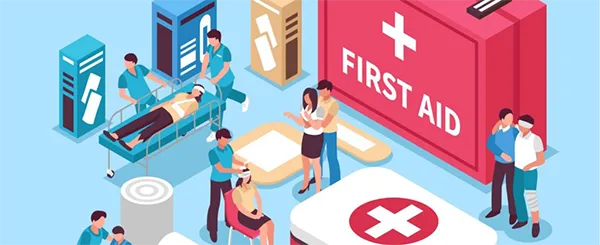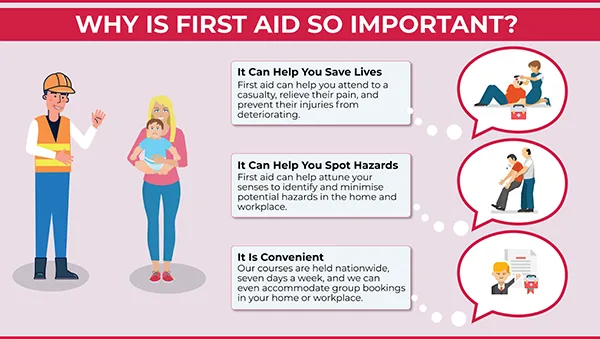
In a time when technology is everywhere, its influence in the field of first aid education is pretty obvious. And this integration is not just a trend.
It is a revolutionary change that will alter the way we view and apply first-aid training.
New tech-driven methods and ideas are starting to replace the traditional book and mannequin system of teaching.
First aid is not just about convenience anymore. It’s a matter of life and death. The quicker and more effectively one can administer first aid, the higher the chances of saving a life.
Using the power of tech in educating people about first aid can provide them with the necessary skills and confidence they need to act decisively in times of emergencies.
They combine convenience, flexibility, and quality, making first aid education accessible to everyone, regardless of geographical location or schedule limitations.
These courses are carefully designed by experts to ensure that the content is both accurate and up-to-date.
The online platform’s interactive features, like real-time quizzes, video demonstrations, and feedback, improve understanding and retention.
Virtual reality is much more than a tech or gadget for enthusiasts and gamers. The field of education is being revolutionized by it, especially in the area of practical application, such as first aid.
VR can offer an immersive experience by allowing users to step into realistic emergency simulations without any real-world risks.
This kind of hands-on approach not only helps develop muscle memory but also helps the students build their confidence.
Smartphones are the norm these days, and mobile applications hold the key to the future of first aid training.
These apps can serve as a pocket guide by offering step-by-step instructions about various first aid procedures.
From treating basic injuries to CPR methods, these apps can help even a layman understand the best techniques to use in an emergency through interactive diagrams, videos, and images.
DID YOU KNOW?
The use of CPR dates all the way back to 1740, yet even today, many individuals don’t know how to perform it. Given properly and immediately to sudden cardiac arrest victims, CPR can save lives.
These types of learning tools are designed to engage learners more actively.
These modules allow the students to learn at their own pace as well as revisit complex topics if needed.
Because these modules are interactive, students are guaranteed to do more than just read the material. Their ability to communicate, participate, and apply what they have learned can aid with comprehension and memory.
AR can very easily bridge the gap between our digital and physical worlds.
AR apps and devices can overlay digital information into the real world and also provide us with guidance during emergencies.
One can simply use a smartphone camera and receive real-time instructions on how to treat a condition in real-life cases.
For those who are nervous and maybe administering first aid for the first time, AR’s real-time guidance can be very helpful.
Social media has allowed a global community of first-aid professionals and enthusiasts to come together.
Many groups and forums on social media sites like Facebook, Twitter, and LinkedIn are devoted to first-aid topics, information exchange, and peer education.
These platforms enable the real-time sharing of concepts, knowledge, and best practices.
The Internet has streamlined the whole certification process. Gone are the days of waiting for weeks for test results or traveling long distances for certification exams.
Today, anyone with internet access can enroll in these courses and get proper training on first aid methodologies.
Also, those who find it hard to attend classes in person due to work or other reasons can benefit greatly by attending online training through a registered training organization.
Intriguing Fact:
Up to 46% of bicycle-related injuries of youths could be prevented with the utilization of first aid skills.
By tracking a learner’s progress, educators can identify areas that might need additional attention and resources.
Data analytics can provide valuable insights into modules or techniques that are more effective and allow for continuous improvement and training.
For a student, analytics can offer a clear roadmap of their progress as well as point out their strengths and weaknesses.
First-aid training has always been based primarily on simulations. But these simulations are getting more and more realistic as technology advances.
Tech-driven simulations are capable of accurately simulating a variety of emergencies, including house accidents and natural disasters.
These lifelike scenarios can give the students practical experience and let them hone their skills in a safe but realistic setting.

Subtitle: Importance of First Aid
It seems obvious that the combination of technology and first aid training will only get better as we look to the future.
Only by using AI to develop specialized training that meets each student’s needs specifically, will we be able to predict the emergence of a more tailored learning experience.
Also, the boundaries between physical and virtual training might blur even further, with AR offering the best of both worlds.
It is a course that gives everyday people the knowledge and skills to respond to a medical emergency until more qualified help can arrive.
The validity of certificates for first aid at work is three years. First-aiders must complete a requalification course as needed before their certificates expire to renew for an additional three years.
You will gain knowledge on how to assess a victim, maintain scene security, administer basic life support (BLS) and resuscitation, operate an automated external defibrillator (AED), handle bleeding, and handle trauma.
